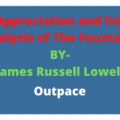First Stanza
“A
free bird leaps
on
the back of the wind
and
floats downstream”
The first verse is replete with the notion of liberty.
The poem opens with reference to the flight of a free bird who springs free
from the ground to fly in the guidance of the air current. It is as if it
glides it the lap of the sky. The words “ leaps on the back of the wind” and “ floats
downstream” capture the ease of movement which freedom brings along.
“till
the current ends
and
dips his wing
in
the orange sun rays
and
dares to claim the sky.”
Here, the movement of the bird in the sky is depicted.
It looks as if the bird had submerged in the orange hue if the sun covering the
sky. The bird glides in the atmosphere. Gliding, unlike flight, is a low strength
consuming recreation which the poem describes as an effortless, leisurely
movement. It grips an exclusive white-privilege and brings forth the
opportunities and possibilities which a socially acclaimed individual can
attain.
Second Stanza
“But
a bird that stalks
down
his narrow cage
can
seldom see through
his
bars of rage”
The second stanza begins with a “But” which reflects a
sharp contrast between the first and succeeding stanzas. The state of
confinement of the caged bird is echoed throughout the following lines. The
shackles were so powerful that the bird is caged in both physical and
psychological perception. Generations of racial bias have rendered him blind
with resentment that he seldom sees through his bars of rage.
“his
wings are clipped and
his
feet are tied
so
he opens his throat to sing.”
The wings of the bird are clipped and his feet are bound.
He could hardly move — which is a sharp contrast to the free bird which glides
and strides in the open sky and even “ dares to claim the sky”. The poem works
with stark opposing imageries, juxtaposed against each other. Here, the caged
bird sings out of suffering. An abolitionist Frederick Douglass once said, “Slaves
sing most when they are most unhappy”. The cage limits the bird’s “ line of sight”
and it sings in grief.
Third Stanza
“The
caged bird sings
with
a fearful trill
of
things unknown
but
longed for still”
These is the most poignant lines of the poem. The
caged bird hasn’t encountered the type of freedom the free bird experiences. It
quavers while singing of the things unknown. The bird knows nothing about the
freedom but still longs for its existence because the core of it recognizes it
as a basic requirement.
“and
his tune is heard
on
the distant hill
for
the caged bird
sings
of freedom”
The cry for freedom of the bird is heard in distant dwellings.
Poem describes the opposing experiences of the caged bird and its counterpart. All
that the caged bird could do to attain the liberation is by raising its voice
against the injustice. This idea is particularly notable, as it reminds one of
the time with Angelou along with Martin Luther King Jr., was an active participant
in the Civil Rights Movement.
Fourth Stanza
“The
free bird thinks of another breeze
and
the trade winds soft through the sighing trees”
These lines go back to the unrestricted movement of
the free bird. These shows us how one’s surrounding play an integral part in
shaping one’s aspirations and one’s vision of the self. The brilliant visual,
aural and palpable imagery captures the delight of the free bird. The idea of
ease and abundance is predominant here.
“and
the fat worms waiting on a dawn bright lawn
and
he names the sky his own”
In the following lines, we find that the independent bird
is exposed to the abundance of nature. It can fly freely and satisfy its hunger
on “fat worms”. Visual imagery of nature is prominent in use if words like- “
dawn”, “bright lawn”, “ sky”. The bird is so free that he supposedly “ names
the sky his own.”
Fifth Stanza
“But
a caged bird stands on the grave of dreams
his
shadow shouts on a nightmare scream”
The cage has now become the grave of the bird’s
ambition. The damage that has been done to the bird’s sanity can be measured by
the fact that his shadow shouts on a “nightmare scream” resulting from the
frustration. The imagery of death and suffering prevails in these lines.
“his
wings are clipped and his feet are tied
so
he opens his throat to sing.”
These remind us of the condition of the caged bird in
the former lines. Angelo paints a vital portrait of oppression in which she
illuminates the privilege and entitlement of the uncompressed, and conveys the event
of suffering and emotional strength.
Sixth Stanza
The sixth stanza is a refrain of the stanza three.
This repetition, in turn, gives a bold
assertion of the agency of the caged bird. She years for a condition which is
inherently attached to its very presence: the state of being free.




